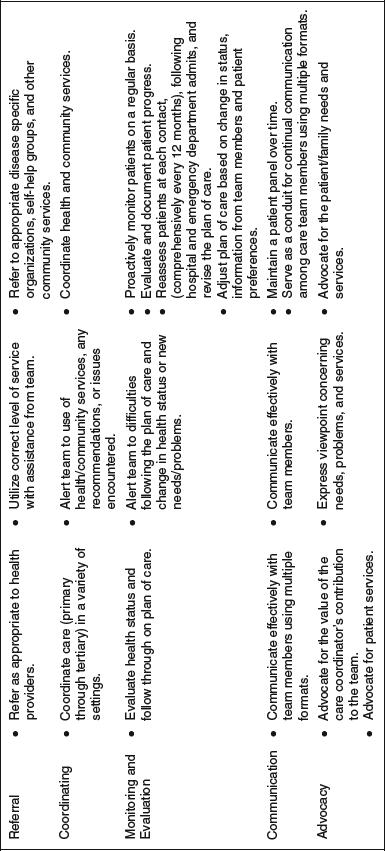
Team development
Interdisciplinary team development requires dedicated, coordinated work. How a team operates relates to its institutional location and structure. These can range from primary care, clinic-based comprehensive interdisciplinary teams to two-person teams, or to virtual teams made up of a network of health care providers located at a variety of institutions (Dorr et al. 2006; The John A. Hartford Foundation, 2007a; Weiss et al. 2010).
No matter the structure or the location, an essential team strategy must uphold respectful, concise inter-professional and intra-professional communication. Effective communication must occur to ensure consistency between the goals of the patient/family, the care coordinator, the physician, and other team members. Consistent, respectful communication supports the development and implementation of effective care plans. Active participation by all team members in program and protocol development, patient care coordination, and ongoing program evaluation helps build cohesiveness and respect for each team member’s expertise (Dorr et al. 2006; Dorr et al. 2007; Xyrichis & Ream 2007).
Care management teams can improve the quality of care for patients with complex, chronic health needs. Their success, however, is determined not only by their ability to function effectively on an interpersonal level, but also on the ability to target appropriate clients for the care management process.
Targeting the appropriate population
Central to the success of any model of care coordination is the ability to identify patients who need, and potentially might benefit from, more comprehensive care. Although the general consensus is that targeting higher-risk patients is important, no commonly agreed upon criteria exists for identifying these potential patients. As a result, some care management models target patients with specific diseases, some rely on physician and other provider referral, and others rely on a combination of clinical, demographic, psychosocial, and utilization data to select high-risk patients.
Instruments used to identify high-risk patients include the Pra (probability of repeated admission) and PraPlus. These screening instruments identify older individuals at risk of future health service use over a two- to four-year time period (Pacala et al. 1995; Pacala et al. 1997; Boult et al. 1998; Boult et al. 2001). They have been used with a variety of populations over 15 years by researchers and health care organizations to prospectively identify individuals at risk for substantial health care utilization and higher costs. Another example is the Vulnerable Elders Survey (VES-13), which assesses an individual’s functional disability (Saliba et al. 2000; Saliba et al. 2001). The VES-13 is a simple, function-based screening tool for identifying community-dwelling older adults at risk for health deterioration. The instrument can be administered in person or over the phone by non-clinicians in a variety of settings. The VES-13 has been shown to be an accurate predictor of functional decline and mortality in older, ambulatory care patients over a five year period (Min et al. 2009). Higher VES-13 scores of elderly individuals have been associated with increased utilization of ED visits and inpatient and outpatient hospital services (McGee et al. 2008). Research suggests that the VES-13 can be useful in identifying community-dwelling older adults who need assessment and coordinated care interventions, as well as a pre-screening tool for identifying elderly cancer patients for comprehensive geriatric assessment (Kellen et al. 2010), but additional prospective studies are needed to assess its overall clinical utility.
Another example of a screening instrument that has been widely used is the Charlson Comorbidity Index (CCI; Charlson et al. 1987), originally designed as a severity of illness measure. The CCI was originally constructed to predict longitudinal mortality risks for hospitalized patients based upon weighted scores assigned to 22 co-morbid conditions. The original index was calculated via medical record review, but was subsequently adapted so that International Classification of Diseases, Ninth Revision (ICD-9) codes could be used to calculate the score (Deyo et al. 1992). Additionally, a self-report CCI score has been developed (Chaudhry et al. 2005). Recently, an adapted version of the CCI was used with community-dwelling, primary care patients to predict total annual health care expenditures (Charlson et al. 2008). Using this approach, the researchers identified advanced age (Medicare and/or Medicare eligible), multiple co-morbidities (based on a CCI score of 3 or higher), and previous hospitalizations as significant predictors of higher resource utilization and higher annual costs.
Researchers have also used a sequential approach to identify patients at risk for high health care use. A two-step sequence that selectively administers laboratory tests based on findings from a short self-report questionnaire has been successful in identifying elderly candidates for care coordination (Reuben et al. 2003). The difficulty with this type of approach is that it is predicated on the ability to obtain readily available and up-to-date laboratory values from the surveyed patient population.
An example of a computerized, predictive modeling system is hierarchical condition categories (HCC; Pope 2004), which produces diagnosis-based clinical measures based on disease burden and places individuals into risk categories. An example of HCC is the Adjusted Clinical Groups Predictive Model (ACG-PM), which is part of the John Hopkins ACG Case Mix System (Weiner et al. 2003). The ACG-PM software uses administrative data to compute the probability that individuals will rank in the highest 5% of the population for medical expenses during the following 12 months. The ACG-PM has been used in several studies to identify potential patients for coordinated care interventions (Sylvia et al. 2008; Leff et al. 2009). Two other examples of diagnosis-based computerized systems are the Adjusted Clinical Groups (ACGs) and Diagnostic Cost Groups (DCGs; Rosen et al. 2005).
Patient surveys, provider referrals, and predictive modeling can be effective, but may be both expensive to initiate and based on inaccurate subjective and clinical data. Regardless of the risk-based targeting method or strategy used, care coordination programs are more likely to have success if they target patients who are at very high risk of hospitalization(s) in the coming year and have multiple chronic illnesses, including congestive heart failure (CHF), coronary artery disease (CAD; acute myocardial infarction and ischemic heart disease) and chronic obstructive pulmonary disease (COPD) (Miller & Wiessert 2000; Peikes et al. 2009; Sylvia et al. 2006). Additional characteristics that should be considered include fair or poor self-rated health (Idler & Benyamini 1997), impaired functional ability (one or more ADL or IADL limitations; Sylvia et al. 2006), cognitive difficulties (dementia and depression), and other mental health needs.
Brown (2009) examined successful care coordination interventions and concluded that programs have a higher likelihood of success if they identify patients at substantial risk of being hospitalized in the coming 12 months, but not necessarily in the highest cost categories. Peikes and colleagues (2010) identified two target groups of elderly adults who appear to be likely candidates for care coordination programs. The first group is comprised of individuals who have been hospitalized one or more times in the past year and have been diagnosed with CHF, CAD and/or COPD. These target patients are potentially attractive for care coordination programs because they represent 18% of the current Medicare fee-for-service population, and they account for approximately 37% of expenditures in the 12 months after identification and 32% over the three years after identification. The second group consists of patients who have been hospitalized at least twice in the previous 24 months and have any of the following chronic illnesses: Alzehimer’s disease/dementia, arthritis, atrial fibrillation, cancer, chronic kidney disease, CHF, COPD, depression, acute myocardial infarction/ischemic heart disease, diabetes, osteoporosis, and stroke/transient ischemic attack. The researchers suggest that these eligibility criteria have clinical validity and individuals can be readily identified using a variety of methods, including provider claims, patient self-report, and physician referrals.
Care coordination process
This section describes the essential care coordination processes synthesized from research reviews of methods, documents, and tools with programs that have demonstrated reduced hospital admissions and Medicare expenditures. The interventions were identified by Boult and colleagues (2009), Brown (2009), and Bodenheimer and Berry-Millett (2009). Successful interventions included components of transitional care (Naylor et al. 2004; Coleman et al. 2006), as well as comprehensive care management programs, including Care Management Plus (Dorr et al. 2007; Dorr et al. 2008), Geriatric Resources for Assessment and Care of Elders (GRACE; Counsell et al. 2007; Counsell et al. 2009), Guided Care (Boyd et al. 2007, Boult et al. 2008; Sylvia et al. 2008; Boyd et al. 2009; Leff et al. 2009), and four sites that were part of the Centers for Medicare & Medicaid Services Medicare Coordinated Care Demonstration (Brown 2009; Peikes et al. 2009; Peikes et al. 2010). (See Table 5.2 for a synopsis of the processes for each of the seven programs). The care coordination process includes targeting the appropriate patient population (described above), a comprehensive assessment, care planning, guideline development, teaching/coaching patient and family self-management skills, transitional care, provider coordination, proactive monitoring and evaluation, along with ongoing guidance and support. Patients are encouraged to assume an active role in the management of their chronic health conditions. It has been shown that collaborative partnerships can increase the efficiency and effectiveness of health care services, enhance accessibility of care, maintain or improve quality of care, decrease costs, and improve patient and provider satisfaction (Bodenheimer et al. 2002a, 2002b).
Table 5.2 Care Coordination Components Evidence
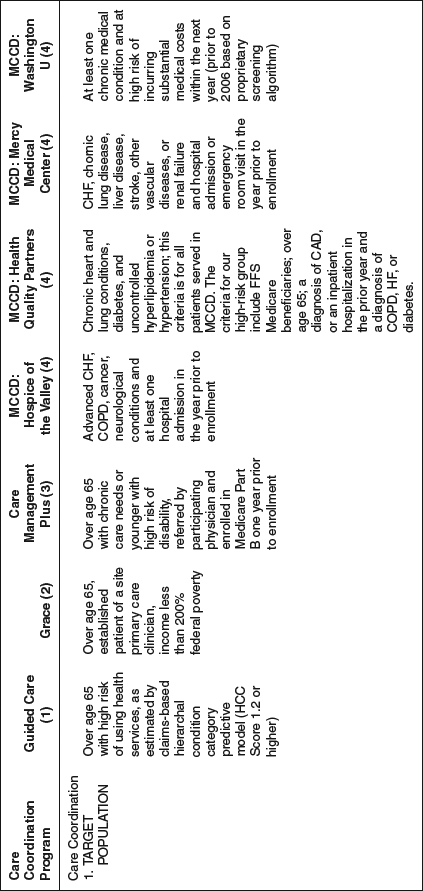
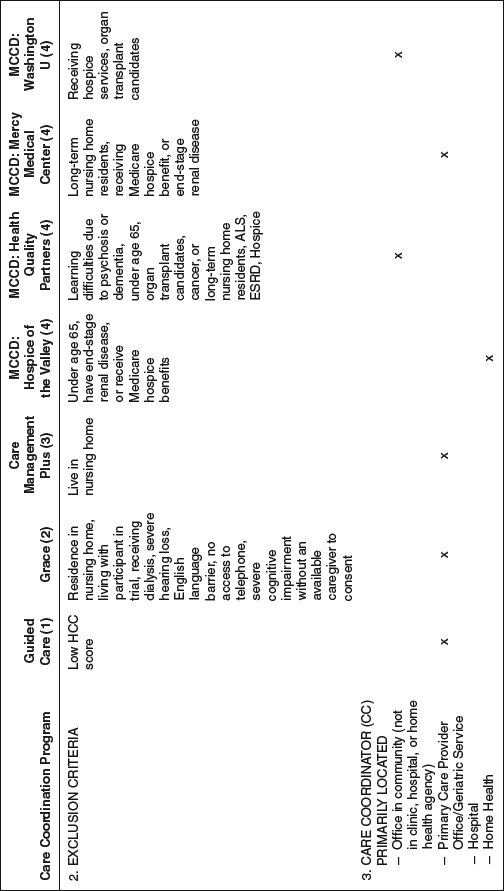
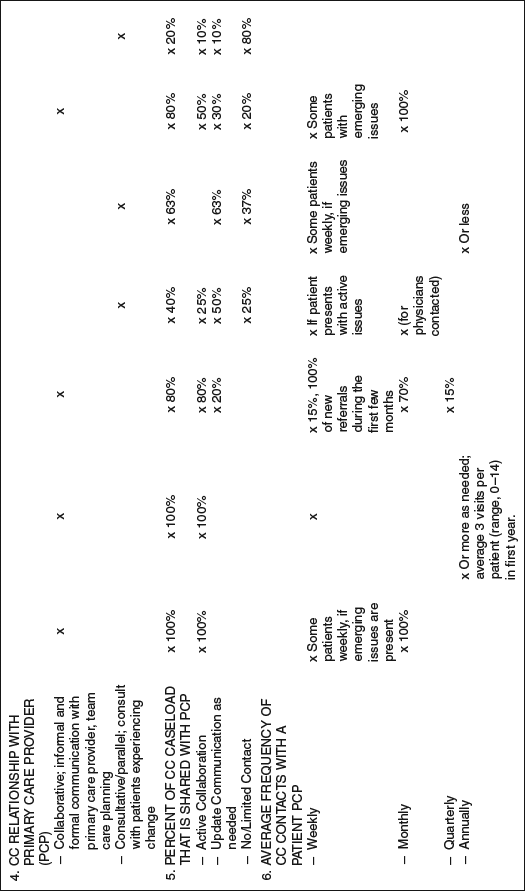
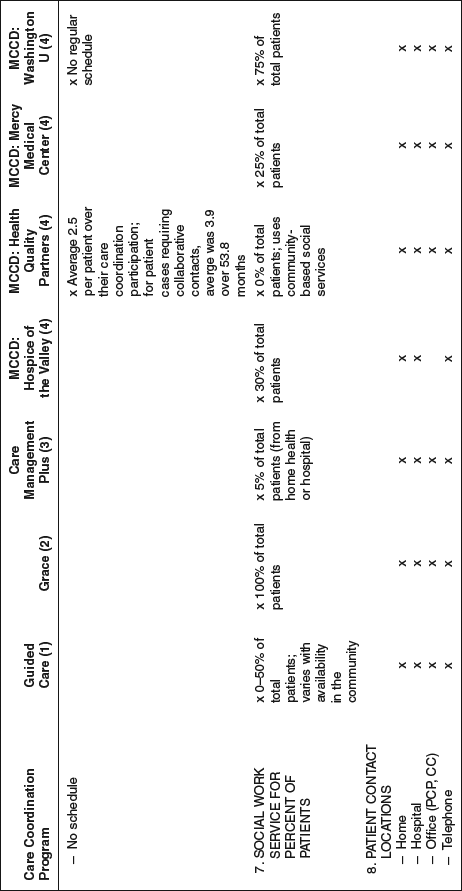
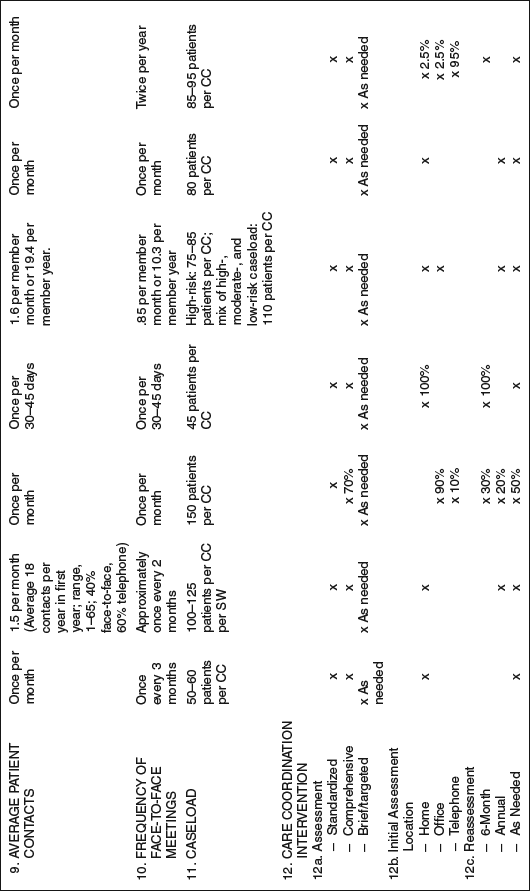
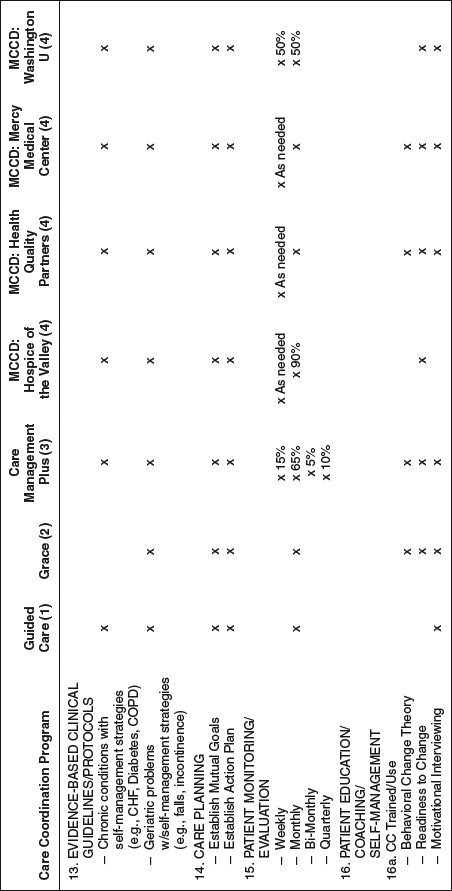
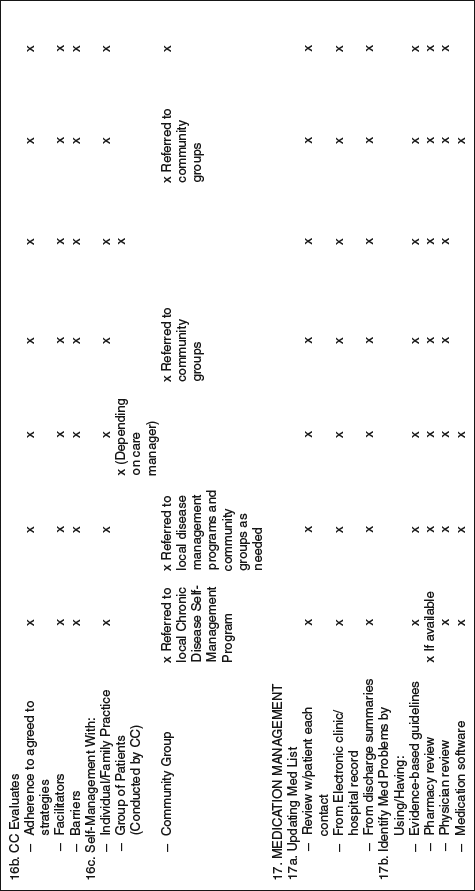
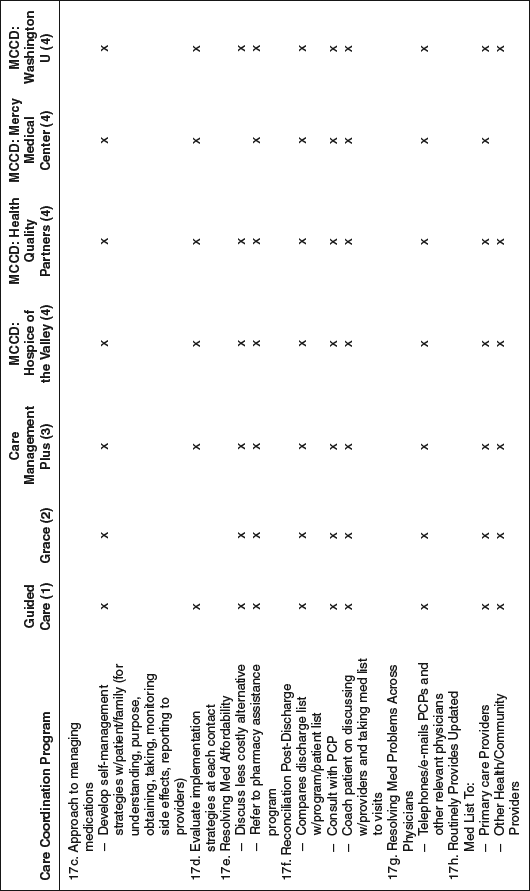
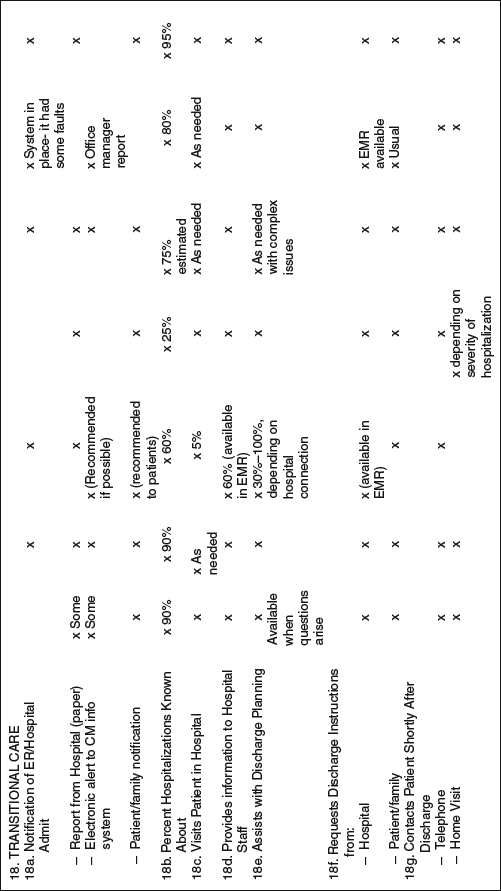

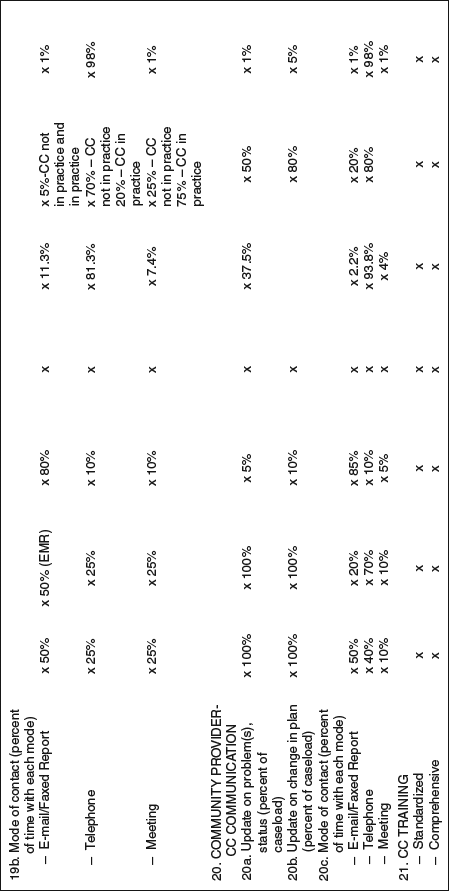
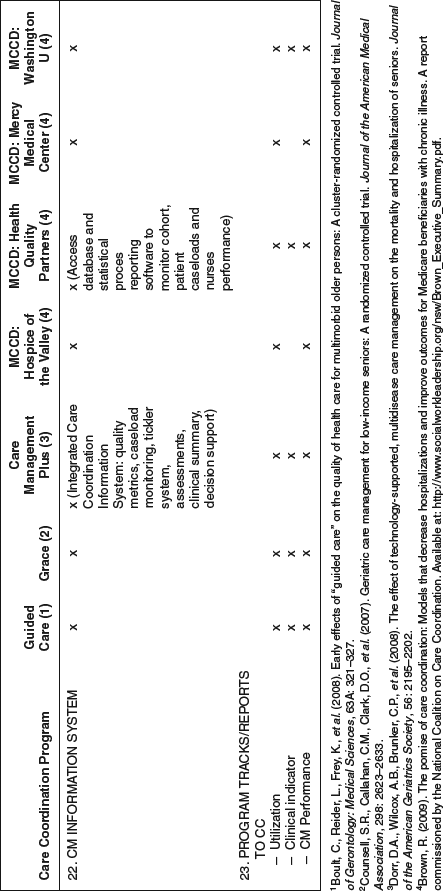
Comprehensive assessment
Comprehensive assessment is essential to understanding the health care needs of medically complex patients. A comprehensive assessment is completed by the care coordinator for each patient and applicable caregiver. The assessment begins in an initial face-to-face meeting (in-home, primary care provider’s office, or medical clinic). If possible, the assessment is completed in the patient’s home. The assessment may be completed during multiple visits with the patient and caregiver, if necessary. In care management, the assessment is both interdisciplinary and multidimensional, and addresses functional abilities in physical, social, and psychological domains. Comprehensive geriatric assessments are usually done at initial enrollment into a care coordination program, after hospitalizations for acute illness, when a change in living status is being considered (for example, nursing home placement), after any abrupt change in physical, social, or psychological functioning, when a second opinion is needed on a suggested intervention or treatment protocol, and at predetermined intervals for the person with complex health needs (Tabloski 2006; Schraeder et al. 2008).
Comprehensive assessments are beneficial to both patients and clinicians. For patients and families, they allow goals, needs, and concerns to be made explicit. Assessments highlight risk factors that may need to be addressed so proactive strategies can be developed to anticipate change and reduce caregiver stress. For the clinician, comprehensive assessments can improve diagnostic accuracy by monitoring the patient’s status, identifying problems early and collaborating with interdisciplinary team members to develop appropriate interventions (Tabloski 2006; Cress 2007; Schraeder et al. 2008).
Care coordinators assess their clients through the systematic collection of both subjective and objective data. This data includes analysis and application of information provided from discipline-specific assessments (for example, nutritionists). The data can include physiological, psychological, sociological, cultural, developmental, and spiritual information (Weber 2008) as well as demographics, financial, environmental, functional, caregiver services, and utilization data.
There are two methods commonly used by care coordinators to assess behavioral attitudes toward lifestyle change: readiness to change and motivational interviewing. Readiness to change is identified through a transtheoretical assessment of the five stages a patient moves through as they seek change in their lives (Prochaska & Velicer 1997). Precontemplation is the stage in which patients are not ready to make any changes and may deny that they need to change. Contemplation is the stage in which the patient becomes aware the behavior exists and is weighing its consequences. Preparation to change occurs when the patient may have changed their behavior for a short time but reverted, and is not sure they want to change. When the patient is actively working toward a change, they are in the Action stage. Maintenance is the stage in which the change has occurred and the patient is focused on not relapsing. Relapsing is the stage in which the patient returns to previous behaviors.
Motivational interviewing is an effective strategy used by some care coordinators to both improve communication and stimulate behavior change (Anstiss 2009). The use of motivational change techniques help patients consider the possibility of change, analyze the risks and benefits of change, and prepare them to move forward if they decide to change (Rollnick 2008). In applying the motivational interviewing technique, the patient is asked to identify the most significant concern related to their health and examine their readiness to make changes to improve their health status. The care coordinator focuses on the patient’s vision, values, and goals.
The information collected documents the patients’ perspectives on the most difficult aspect of managing their illnesses; the reason they came to see the team; their biggest fears; what they already know or have been told about their conditions; and their goals for care. This information helps the care coordinator determine both the focus of care and the priority of patient issues. The care coordinator can provide education and address misinformation that may be increasing the patient’s anxiety. Experienced care coordinators find that effective use of motivational interviewing allows them to not only empower patients with self-management strategies, but also build a relationship of trust and communication (Larsen 2009).
Assessing patients and families
Comprehensive caregiver/family assessments are very challenging and require practitioners to develop effective relationships with both patients and caregivers. These relationships allow the team to monitor changes in health status, work within existing funding constraints, and help the family coordinate care from a mix of providers through periods of acuity, maintenance, rehabilitation, and transition.
When working with caregivers, family-focused care management strategies include attention to their cultural background, health literacy, and social support. Research on caregiver assessment supports the need to focus on three specific areas: the caregiving context, the service setting, and the program (Cress 2009). A caregiver assessment gives the care coordinator an opportunity to evaluate the caregiver’s needs. It also gives the caregiver a voice and helps acknowledge and affirm the important role they play in the patient’s health. Through a trusting caregiver-care coordinator relationship, problems can be identified early and interventions made to protect both the patient and the family member (Cress 2009).
Another benefit of a caregiver assessment is the ability to determine eligibility for support services (e.g., Medicaid). Finally, family caregiver assessment can highlight environmental problems that may interfere with care, such as an unsafe home that presents a major fall risk for the patient (Family Caregiver Alliance 2006). Both the patient and caregiver assessments, combined with a number of other measures, become part of the information necessary to evaluate the effectiveness of a care coordination program.
Guideline development/implementation
Evidence-based guidelines and protocols are incorporated into care coordination programs. Nationally approved guidelines and protocols are accessible from many sources. Care coordination sub-committees review and evaluate guidelines and protocols and establish guidelines for the care coordination team. The care coordination guidelines and protocols address recommendations for medical, nursing, and self-management. Once guidelines and protocols are developed they are reviewed and updated regularly to include the latest advances and recommendations in health care, health promotion, and self-management. The care coordination team is monitored for implementation of guidelines/protocols and the patients are monitored for adherence to agreed upon strategies and recommendations.
Care planning
The care coordinator uses the assessment data to formulate a plan of care that is developed and provided in accordance with evidenced-based practices (EBP). EBP uses the best available evidence in combination with clinical expertise in order to establish guidelines and protocols. Patient preferences are considered to achieve the best possible outcomes. If evidence is unavailable, the care provided should reflect a consensus from expert panels.
The care coordinator helps the patient identify their care preferences, including advance directives. The care coordinator is also in a position to identify undiagnosed co-existing conditions, such as mental health concerns, and refer the patient for additional care interventions. The individualized care plan reflects the patients’ and professionals’ goals for care, and respects the individual needs and cultural backgrounds of patients. Patient-focused plans also explicitly address and reflect the health literacy levels of the patient and caregivers.
To keep the plan patient-focused, care coordinators use educational strategies that promote self-management and autonomy. For example, in diabetes care, patients identify diet-related changes that they are ready to address, life style changes they will make, and change-related timelines they feel are realistic. The care plans also address educational goals related to wellness, health promotion, and prevention of complications.
Care coordinators use flexible strategies that can accommodate the changing needs of patients and their caregivers. Acceptance and ongoing support for the patient and family, even when decisions may not be what the care coordinator feels are optimal, result in the development of trust and respect. This sets the foundation for long-term, supportive relationships. An ongoing role of the care coordinator is that of patient advocate—not only within the interdisciplinary team, but also in the larger health care system and community agency environments.
Care coordinators are responsible for the actual written plan of care. The plan of care is extremely important because it communicates the plan to everyone involved in the patient’s care and promotes continuity and consistency across health care settings while enhancing efficiency and effectiveness of care. Precise and careful planning and the use of evidence based guidelines enable the provision of individualized, efficient, and high-quality care.
The written plan of care identifies potential and actual problem areas, the expected or desired outcomes of care, and the strategies or interventions needed to meet those outcomes. The plan of care is based upon the comprehensive assessment and focuses on techniques that will increase the patient’s knowledge base of his/her chronic conditions, enhance self-management strategies, and coordinate services across health care settings while identifying and addressing barriers to care and gaps in care.
Care coordinators individualize the plan of care based on the patient’s history, signs and symptoms, preferences, and current therapies. Interventions should enhance the patient’s health status, knowledge and self-management skills, teach and monitor medication management and encourage health promotion activities. The care plan intervention should also indicate how to respond to worsening symptoms in order to improve patient outcomes, reduce ED visits and the need for tertiary care. The interventions in the plan of care should facilitate coordination of care across the health care continuum and ensure proactive monitoring and follow up. The interventions are to be specific, realistic, individualized, patient/family centered, cost effective, and focused on patient education, self-management and coordination of care. The roles of individual team members in care planning are outlined in Table 5.3.
Table 5.3 Individual Team Member Roles
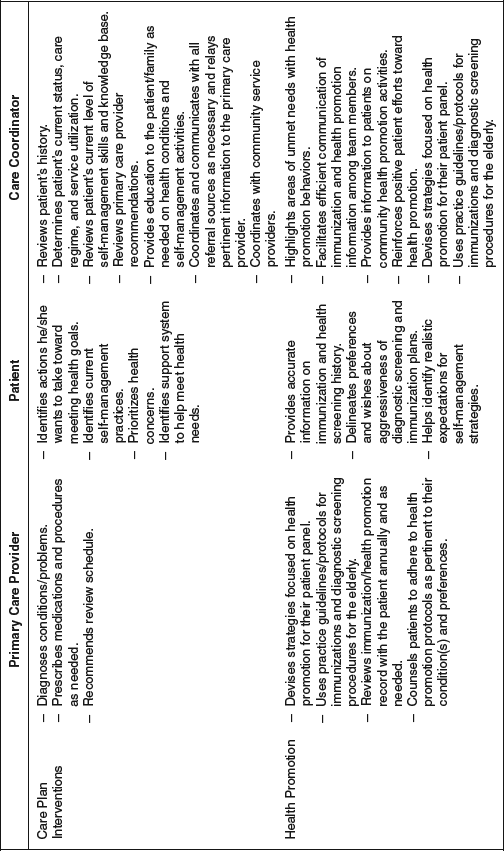
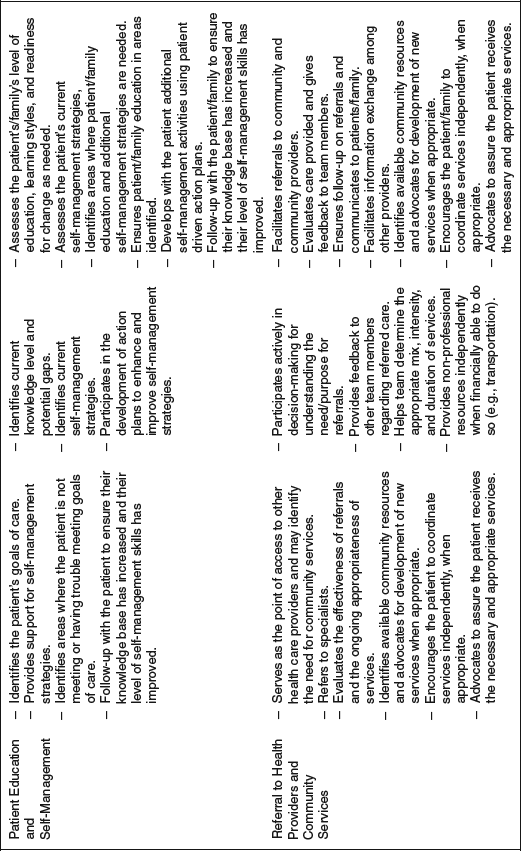
Care plan implementation and monitoring
The implementation phase of the process is based on information gathered during the comprehensive assessment and interventions and strategies outlined in the care plan. Proactive monitoring activities are integrated into the plan of care. Using proactive monitoring, the patient is contacted at predetermined intervals for further assessment, teaching and monitoring of self-management skills, and coordination of care. Patients are encouraged to contact their care coordinator between scheduled contacts if they have questions or need guidance in addressing changes in their condition. Patients and their caregivers/family are asked to report any change in their status or condition, such as a hospitalization or ED visit or if they change their home location. In addition, care conferences may occur with primary care providers and other health care and community providers involved in the patient’s care.
The care coordinator initiates contact with other health providers and community agencies involved in the patient’s care, or a referral can be made to obtain needed assistance for the patient. If a service is already in place, the care coordinator and representative of the agency review the current status of the service and make changes as needed. For a new referral, a plan is outlined to initiate service. Included in the plan are specific tasks and activities that need to be completed, including the specific duties, time frames, and predetermined dates for further contacts to evaluate the effectiveness and coordination of services. Activities and agency contact names and telephone numbers are added to the patient’s plan of care. Future monitoring by the care coordinator assesses the effectiveness of the referral in meeting the patient’s needs. The care coordinator has regular contacts with the home care or community agency to make any needed changes in the plan of care.
A monitoring schedule is established for each patient and their caregiver based on the number and type of chronic illnesses and problems, health promotion activities, recommendations from the evidence-based guidelines/protocols, provider feedback, formal and informal support available, type of medications, self-management activities, health utilization history, and patient/family preference. Monitoring contacts occur via telephone, or face-to-face in the patient’s home, clinical office, hospital, or other agreed-upon meeting sites. The frequency of these face-to-face contacts is based on the patient’s current health status, support system, and plan of care.
During each encounter, the patient should update the care coordinator on current health issues and changes in health status or medications, and results of their self-management activities, such as daily weights, blood sugar monitoring, diet, and exercise/activity level. Teaching/coaching by the care coordinator is included to increase the patient’s ability to self-manage and problem solve. Not only does the patient need to know how to monitor their condition, they need to know how to evaluate indicators of change and develop an action plan with which to address the changes.
Monitoring activities are incorporated into the patient’s care plan and previously agreed to by the care coordinator, patient/family, and primary care provider. Specific information to be monitored is reflective of the care plan content and addresses any newly identified patient needs. The overall status of the care plan is evaluated during the patient/family monitoring process. Consistent, proactive monitoring allows the care coordinator to obtain information that might signal significant decline in health status. This consistent monitoring enables early intervention by the team, possibly preventing a downward spiral in patient health or functional status. At the completion of the monitoring call or visit, the next monitoring date is set and agreed upon.
Inclusion of primary caregivers and family members in care planning is critical to successful self-management. The unpredictability of complex chronic conditions puts caregivers under tremendous stress. This unpredictability presents major challenges in terms of arranging care, managing symptoms, following care guidelines, preventing and managing crisis, dealing with financial strains and insurance companies, coping with daily changes and intrusions from providers, normalizing relationships, coping with career and job strain, and managing role changes within the home.
Self-management strategies
The importance of patient/family self-management cannot be overstressed (Bodenheimer et al. 2002b; Coleman et al. 2004; Lorig et al. 1999; Lorig et al. 2001). Care coordinators will work with patients/families to assess their current level of self-management strategies, assess readiness for change, and teach needed strategies/activities. Interventions will be directed toward empowering them to take ownership of their health care. Patients will be taught problem solving so they can take the data from their self-management activities and act on that information to improve or maintain their current level of health functioning.
In development of a self-management plan, the care coordinator identifies the patient’s current level of health literacy, learning style, readiness to change, and performance of self-management activities. Assessment of the patient’s knowledge and performance of self-management activities starts during the initial comprehensive assessment. Patients are coached to perform self-management activities and instructed in techniques to increase their problem solving ability so they can act on the results. Patients/families are encouraged to participant in community-based educational and support groups. Educational materials, based on evidence-based guidelines, are provided to the patient/family.
Lifestyle modification is included to improve control of current conditions and decrease the risk of developing other chronic illnesses. Examples include diet to control blood sugar or prevent fluid retention, smoking cessation, and increasing exercise/activity levels. Referrals will be made, if necessary, to assist patients in reaching these goals, such as to a smoking cessation program or pulmonary rehabilitation to learn exercise techniques to improve breathing function.
Instruction is provided to patients/families in health promotion and health maintenance activities. Patients/families are given information on the most recent recommendations regarding what types of health promotion and maintenance activities they should engage in, including those that prevent or detect disease (immunizations, mammograms) and monitor for complications of current disease processes (eye examinations).
End-of-life teaching is an important part of patient/family education. Some disease processes can be slowed but will progress in even the most well controlled person. Patients are encouraged to identify their power of attorney for health care prior to having the need for one. Patients are encouraged to complete a living will so their wishes will be known and the appointed power of attorney will have the essential knowledge to carry out the patient’s wishes.
Care coordinators facilitate coordination and education with the goal of no longer needing to intervene in the patient’s care. Patients/families are assisted to understand the types of self-management activities they need to do, when to do them, what to do with the information obtained from these activities, and to know what constitutes an emergency. Care coordinators assist patients and families in outlining the signs and symptoms they can manage at home, which ones need a call and/or visit to the primary care provider and which ones constitute a visit to the emergency department.
Care coordinators use a variety of strategies for enhancing self-management skills of the patient/family. Assessment of the patient/family knowledge-base is ongoing. As care coordinators develop a working therapeutic relationship with patients and families, they will be able to identify barriers that may not have otherwise been found.
The patient’s ability to change and adopt new health care behaviors/strategies may be influenced by his/her relationship with the care coordinator. In many care coordination models, the care coordinator develops close, and at times, long-term relationships with patients and caregivers. Face-to-face time between the patient and the care coordinator has been shown to be critical in the patient’s perception of care; the more face-to-face time, the more satisfied the patient (Dorr et al. 2005; Wenger & Young 2007).
Transitional care
The period following discharge from an inpatient setting is a difficult time for patients. They frequently experience a change in medication and self-management needs. According to Kripalani and colleagues (2007), about 19% to 23% of those discharged experience an adverse reaction, typically related to medications. In a study completed by Coleman and colleagues (2004) patients receiving transitional care were only half as likely to return to the hospital setting. In this study, patients had transitional coaches that assisted with medication management, record keeping, identifying emergent or worsening symptoms, and communication with health care providers. The transitional coaches were Master’s prepared geriatric nurse practitioners who initiated home visits to the patient during the first 24 to 72 hours after discharge.
The results of a randomized study with high-risk hospitalized older adults conducted by Naylor and colleagues (1999) revealed that transitional care from advance practice nurses reduced expenditures and readmission rates. Care was initiated in the hospital with discharge planning and was continued in the patient’s home after discharge. Patients were initially visited in the hospital within the first 48 hours after admission. After discharge, two home visits were conducted. The first was conducted within the first 48 hours after discharge and the second was within the first seven to ten days. The nurses were available seven days a week by telephone and initiated phone calls to the patients at least weekly.
Transitional care is designed to assist patients in smooth transitions from one location or level of care to another. It is defined as a set of activities that ensure coordination and continuity of care (Coleman et al. 2005). After discharge from an inpatient setting, older adults with multiple co-morbid conditions are frequently challenged with managing a new medication regime and a new set of self-management activities. It is imperative that they develop these new skills to ensure management of conditions and prevention of rehospitalization. Nurse care coordinators, especially nurse practitioners, are knowledgeable in medications and medication management and can assist with medication reconciliation at admission to an inpatient setting, transition from one setting to another and discharge to home. They are also knowledgeable in needed self-management strategies and can assist patients/families in assimilating these into their daily routines.
Care coordinators not only provide education on medication and self-management techniques, but they can also assist the patient/family in communication strategies to bridge care, identification of needed home care assistance, and identification and management of symptoms. Care coordinators collaborate with physicians and other health care providers to provide optimal home assistance and support to the patient/family. Patient and family are assisted and encouraged to identify their self-care needs and health status changes and communicate these to their primary or attending physician. It is important for patients to be aware of signs and symptoms that signal when their condition is worsening and what level of care they need to seek.
The care coordinators and the patient/family update the plan of care and develop a follow-up schedule that optimizes the patient’s ability to self-manage at home. Follow-up post transition includes home visits, office visits and phone calls. The type and location of visit is planned into the plan of care. Initial follow-up includes at least weekly contacts and identification of where patients/families can obtain information and guidance if the care coordinator is not available. The duration of the more intensive and proactive follow up is dependent upon the patient and family and available support systems.
Identification and management of care-related barriers
Patients who use care coordination services tend to be those considered at-risk for both adverse health outcomes and, as a result, in need of expensive care. These individuals also tend to use multiple service providers who cut across numerous service sectors (Mollica et al. 2003). For frail elders, the complexity of care coordination needs can become overwhelming. This population tends to use three different provider organizations, with multiple provider visits in each institution (Haggerty et al. 2003). Research has also shown that typical Medicare enrollees saw an average of two primary care physicians and five specialists each year. Patients with several chronic conditions visit up to 16 physicians a year (Pham et al. 2007).
To safely navigate patients through the complex web of health care institutions and community resources, care coordinators must have excellent interpersonal, organizational, and problem solving skills. For the care coordinator, the goal is to link clients with critical community resources and other specialty providers and agencies in a manner that provides the required services at the most appropriate time.
Effective care coordinators develop strong formal and informal networks with providers and community resources. Usually the care coordinator implements a combination of advocacy strategies that may include: quick access to online resources, knowledge of local community agency resources, disease-specific support groups and educational resources, and federal, state, and county government programs (for example, Social Security Administration, Adult Protective Services, senior centers, and so on).
Care plan evaluation
Evaluation of the implemented plan of care is conducted on an ongoing basis. At each contact, the plan of care is evaluated and adjusted to reflect changes in the patient’s status and ability for self-management. Identification of both successful and unsuccessful interventions is noted. Unsuccessful interventions are removed from the care plan and the care coordinator works with the patient/family and primary care provider to determine why the intervention was unsuccessful. New interventions, including those that address any barriers to implementation, are planned, implemented, and evaluated.
All patients are informed of and engage in health promotion activities. Successful plans of care reveal that patients are up-to-date in immunizations and screenings, and they are performing needed health maintenance activities to the best of their abilities.
Plans of care also include guideline/protocol recommendations for management of chronic illnesses. Successful evaluations reveal that patients/families are up-to-date on the guideline/protocol recommendations. The recommended laboratory and diagnostic testing schedules that monitor the condition (that is, Hemoglobin A1c, lipid panels, electrocardiograms), are completed and current, and the patient’s medication regimes are those recommended by the guidelines/protocols. As appropriate, the patient’s family/caregiver is involved in the plan of care and evaluation.
Care coordinator training
Care coordination requires additional education and training for care coordinators. Education and training programs usually cover a wide range of topics, including chronic disease management for the patient and their caregivers, evidence-based chronic illness guidelines and protocols, comprehensive assessment, action planning, coaching, educating, and empowering patients and their caregivers, monitoring and evaluation, self-management with an emphasis on symptom and medication management, transitional care, collaboration with primary care and community providers, patient and panel management, financing of care, quality and outcome reporting, and principles of adult learning and techniques to facilitate behavior change. For example, the care coordination program developed by Boult and colleagues at Johns Hopkins University (Boyd et al. 2007; Sylvia et al. 2008) uses RNs to enhance primary care delivery, focusing on disease management and chronic care. These RN care coordinators receive specific program education and training through a 25-module curriculum. The training program areas covered include chronic disease management, geriatric assessment and care planning, transitional care, electronic health records, patient education techniques and motivational interviewing, cultural care, community resources, communicating with physicians, insurance benefits, and ongoing monitoring and follow-up. After training the RNs spend three months in orientation, working with their respective physicians and office staff. Only after integration into the day-to-day routines of the practice environment do they start contacting patients, conducting assessments and planning care.
Although coordinated care interventions have different delivery structures, programs encompasses a variety of traditional and non-traditional techniques to effectively train care coordinators, especially when confronted with the hectic day-to-day “real world” of medicine. These techniques include lecture formats from experts (for example, physicians, advance practice nurses, pharmacists, exercise physiologists, nutritionists, occupational therapists, social workers, an so on), as well as web-based learning technologies, high definition video, simulated practice, pod casts and RSS feeds. In addition, training also usually includes a supervised orientation period before care coordinators begin working with patients directly on their own.
Information technology and quality reporting
Care coordination models use a variety of information technology (IT) tools, such as virtual networks, electronic medical records, patient-focused web sites to provide health promotion materials, disease coordination strategies, and personalized follow-up reminders (Wilcox et al. 2005; Dorr et al. 2006; The John A. Hartford Foundation 2007b). The use of electronic medical records is considered the basic technology requirement for access to all necessary information at the time patient decisions are made (Reuben 2007). IT tools help organize, prioritize, and track care coordination tasks. They also include decision support reminders for clinicians to provide best practice.
Integrated IT systems compliment the role of the care coordinator and can include such things as a tracking database, a patient summary sheet, and an electronic messaging system (Dorr et al. 2006; Vickery et al. 2006). These electronic clinical supports improve patient safety and support the development and implementation of quality evaluations. The use of clinical information systems is considered an important strategy in the effective coordination of care management activities. These systems can include real-time electronic clinical alerts, a patient tracking system, time and activity reporting systems, and provider and patient reports. Real-time alerts can be sent automatically via e-mail to the care coordinator to report patient ED visits, hospitalizations, discharges, outpatient procedures, and visits with other providers (Schraeder et al. 2005).
Care coordination evaluation
The future success of care coordination interventions will depend on their abilities to show value in terms of benefits to both health and cost. The intervention defined in this chapter is based on the belief that a systematic delivery of key components and services to chronically ill adults will result in improved health status, patient and provider satisfaction, and decreased health care utilization and cost. An evaluation should explain why the intervention fails or succeeds dependent in these key areas.
The design of a coordinated care intervention, including the focus and methods used, must reflect the shared perspectives of the major stakeholders – the funder or funding sources, the sponsoring health care organization, clinical team members, and patients. Identifying the sponsoring organization’s primary goals for conducting the intervention is a critical element of the evaluation. Also, designing an evaluation strategy a priori is important in maximizing the potential applicability of the intervention as well as the ability to provide ongoing feedback to stakeholders, especially the care management team (Mollica et al. 2003) during the intervention.
Evaluation designs typically focus on three primary areas: intervention structure and implementation, quality related care processes, and health care utilization and cost measures. These areas are evaluated within designs that identify treatment compliance measures and behavioral adjustments that are considered accurate indicators of chronic disease outcomes. The approaches are usually standardized and titrated in terms of doses related to the amount of education, support, and monitoring of clinical markers and behavioral patterns related to specific groups of patients (Dorr et al. 2006).
We suggest that to properly evaluate the comprehensive care coordination intervention described in this chapter, emphasis must be placed on both a thorough process and impact analysis. The focus of process analysis is on implementation and fidelity assessment. Impact analysis concentrates on quantifying process and quality of care measures, service utilization and cost outcomes, as well as cost savings derived from the intervention. Process analysis examines a number of areas, including a description of the organizational sponsor and the local and regional geographical health care environment; project staffing, including team composition, care coordinator background and training, caseload sizes, pre-existing relationships with physicians, and so on; identification of and recruitment strategies with the target population, as well as the proportion of the target population that is served by the intervention; a description of the intervention components and how they are maintained/modified over time; care-manager patient and provider contact types; how intervention processes are maintained or increased over time; and how efficiencies are maintained to reduce costs and maximize net savings.
Fidelity assessment examines the extent to which the intervention was implemented as designed and intended, barriers encountered in implementation, and how these barriers are overcome. Researchers have indicated that implementation fidelity has a substantial impact on outcomes (Dane & Schneider 1998), yet it is one of the most prominent limitations of evidence-based intervention evaluation; there is a difficulty identifying which components are most significant and positively correlated with improved outcomes (Grol et al. 1998). Five dimensions have been recommended as important to consider when measuring treatment fidelity (Steckler et al. 2002): adherence (is the intervention being delivered as intended?); dose/exposure (how frequently and intensely are services provided?); quality of delivery (how effective is the intervention?); participant responsiveness (are patients active recipients of the intervention?); and enactment (do patients exhibit healthy behaviors in the right situation at the right time?). In tomorrow’s health care environment it will be imperative to incorporate fidelity measures into evaluation designs.
The nuts and bolts of most care coordination interventions have centered on process and quality of care and utilization measures. Examples of process of care measures include: adherence to specific medical and nursing clinical guidelines; intensity of alerts of patient deterioration (for example, notification of current hospitalization or ED visit); improvement in care transition activities; improvement in patient self-management skills; reduced medication management issues; increased use of preventive services (such as breast and cervical cancer screening, colon cancer screening, prostate cancer screening, vaccines [flu, pneumococcal, hepatitis B]); and increased use of disease specific services (such as fasting blood-glucose tests and eye exams for diabetes, blood tests for elevated lipids for diabetes and CAD). Examples of quality-of-care related outcomes include patient and physician global satisfaction with intervention services; increased patient satisfaction with specific services (for example, arranging payment for non-covered services or medications, helping make appointments with specialist physicians or therapy services); increased patient knowledge and adherence to therapeutic regimes; improved physical and mental health and health-related quality of life; and a decrease in all-cause mortality. For additional process and quality of care measures see the USPSTF (U.S. Preventive Services Task Force) guidelines for older adults and Assessing Care of Vulnerable Elders indicators (Wenger et al. 2007).
Examples of service utilization outcomes measure the probability of any utilization use (for example, hospital admissions and readmissions, potentially preventable hospital admissions, ED visits with and without hospitalization, skilled nursing facility (SNF) admissions, home health visits) and the amount of each health care service received, including the total days of care for hospital and SNF care. Costs of care include expenses for inpatient and outpatient care and total costs, usually reported in monthly or yearly increments, and projected net savings, with and without intervention costs.
While we have outlined a general approach to evaluating coordinated care interventions, translating quality research findings into practice requires visionary leadership. Even with such leadership, the delivery of care coordination faces many internal and external challenges to its success. Some of these challenges are discussed below.
Ongoing care management coordination challenges
Challenges to care management are not limited to the complexity of medical conditions or to the multifaceted interactions between patients, providers, and caregivers. Effective care management faces both internal and external challenges.
Internal challenges relate to providers who do not understand their patients’ needs and do not make appropriate referrals to care management teams. This problem is thought to reflect the lack of education in professional programs that help students prepare for the level of interdisciplinary cooperation needed to care for patients with complex needs (Boult et al. 2009; Reuben 2009).
Providers may also believe that the use of evidence-based care takes more time than simply using the status quo. Some also report a belief that the use of guideline-specific care will not result in the desired outcomes (Tabloski 2006; Cress 2007; Reuben 2007).
In addition, many providers have limited knowledge of resources that could help their patients and families. These include community agencies, government programs, and disease-specific support groups that can help patients cope with their illness. Patient and caregiver issues also present challenges due to the complexity of issues they face and variations in their interest in, and ability to, adhere to treatment recommendations. The lack of family resources, either social or economic, can also produce significant challenges to effective care management (Reuben 2007).
Administrative issues can present significant internal challenges. Administrative support is critical and can only occur if administrators are convinced that research-based innovative models make good business sense. Innovations must be simple to understand and compatible with existing values. They must also give a sense of being more advantageous than current practices (Reuben 2009).
Aside from internal challenges, there are also significant external issues related to care management coordination (Bodenheimer 2008). One of these is the current status of the primary care system. Due to a lack of integrated systems of care, the primary care system provides an ineffective and inefficient delivery of care to older adults. In addition to the fragmented system, the future U.S. workforce is not projected to consist of the professional mix needed to staff multidisciplinary teams (Bodenheimer et al. 2009).
This primary care crisis is exacerbated by the fact that electronic medical record systems have yet to be systematically implemented. Research into the benefits of electronic medical records is still developing. Initial research results do indicate that electronic medical records have the potential to increase patient safety and reduce costs (Bodenheimer 2007; Bodenheimer 2008).
Reimbursement issues add to the external challenges faced by care management models. Currently, Medicare’s reimbursement approach favors acute care situations. This results in minimal reimbursement options for innovative models that focus on wellness and cost-effective health promotion (Weiss et al. 2010).
Some researchers believe the best short-term opportunity for reducing costs is improving transitions from hospital to home. Payment reform initiatives could be used to incentivize hospitals and primary care practices to implement these programs. It has been suggested that tying physicians’ compensation to quality and efficiency scores may increase the appeal of comprehensive care coordination services. In addition, it has been suggested that Medicare and Medicaid consider a separate reimbursement system for care coordinators implementing proven interventions with targeted, high-risk groups (Schraeder et al. 2005).
Evaluation challenges are ongoing in the care coordination arena. While great value is placed on quantitative research designs, cautionary notes are also raised regarding the danger of using standardized measures to such a degree that the diversity of patient needs is missed. Some researchers express concern that reducing chronic disease management to a standard “dose” for diverse patients will unintentionally create systematic inequities and endanger the health system’s most vulnerable populations. Some of these vulnerable groups include individuals from diverse cultural backgrounds, people with limited health literacy, and patients in specific age-related cohorts (Yu et al. 2008). Qualitative researchers call for a balance that acknowledges the importance of subjective and interpretative data elements that can provide context for quantitatively derived models (Thorne 2008). While data and information on different models and approaches are available, it is not comparable and thus limits the ability to make comparisons across programs (Kodner & Kyriacou 2000).
Conclusion
Effective care coordination bridges the gap between the needs of people with complex chronic health conditions, disease illness, and the fragmented system of care.
Essential components of care coordination include a collaborative, interdisciplinary team, longitudinal care coordination with the patient/caregiver, implementation of the care coordination process, patient/caregiver empowerment and self-management, effective transitional care, identification and management of care-related barriers and facilitators, use of information technology, and consistent, systematic use of evaluation strategies. These components are operationalized through specific care coordination strategies such as team development, training and mentoring care coordinators, targeting appropriate patients, managing barriers, implementing the care management process which includes the use of evidence based guidelines and protocols, and formulating valid and reliable evaluation strategies. The specific functions of care coordinators are central to the care coordination process.
While there is significant potential for coordinated care management to improve the patient’s quality of care and decrease system fragmentation, there are also significant challenges to its use. Some of these challenges are internal and relate to the physician’s ability to engage in interdisciplinary care, generalizable evaluation strategies, and administrative support. External challenges are found at the system level and reflect a compromised primary care system and the lack of professional workforce mix to meet the changing demographic demands of the aging population. The lack of systematic implementation of clinical information systems and the lack of incentives to use and evaluate creative care management models also presents significant, ongoing barriers.
While the challenges are significant, the pending demographic changes may be the impetus that forces the types of transformations needed to support coordinated care management. Visionary care coordination proposals will include interdisciplinary teams, evidence-based care, creative use of information technology systems, and comprehensive evaluation strategies that result in improved care and quality of life for people with complex, chronic health conditions.
References
Ahmed, A. (2002) Quality and outcomes of heart failure care in older adults: role of multidisciplinary disease-management programs. Journal of American Geriatrics Society, 50, 1590–1593.
Anstiss, T. (2009) Motivational interviewing in primary care. Journal of Clinical Psychology in Medical Settings, 16(1), 87–93.
Bodenheimer, T., Wagner, E. H., & Grumbach, K. (2002a) Improving primary care for patients with chronic illness. Journal of the American Medical Association, 288, 1775–1779.
Bodenheimer, T., Wagner, E. H., & Grumbach, K. (2002b) Improving primary care for patients with chronic illness: the chronic care model, Part 2. Journal of the American Medical Association, 288, 1909–1914.
Bodenheimer, T. (2007) Coordinating care: a major (unreimbursed) task of primary care. Annals of Internal Medicine, 147, 730–731.
Bodenheimer, T. (2008) Coordinating care – a perilous journey through the health care system. The New England Journal of Medicine, 358, 1064–1071.
Bodenheimer, T., & Berry-Millett, R. (2009) Care Management of Patients with Complex Health Care Needs. Robert Wood Johnson Foundation, Research Synthesis Report 19, Princeton, NJ.
Bodenheimer, T., Chen, E., & Bennett, H.D. (2009) Confronting the growing burden of chronic disease: can the U.S. health care workforce do the job? Health Affairs, 28(1), 64–74.
Boult, C., Pualwan, T.F., Fox, P.D., et al. (1998) Identification and assessment of high-risk senions. American Journal of Managed Care, 4, 1137–1146.
Boult, C., Kane, R.L., Pacala, J.T., et al. (1999) Innovative healthcare for chronically ill older persons: results of a national survey. American Journal of Managed Care, 5, 1162–1172.
Boult, C., Boult, L.B., Morishita, L., et al. (2001) A randomized clinical trial of outpatient geriatric evaluation and management. Journal of the American Geriatrics Society, 49, 351–359.
Boult, C., Reider, L., Frey, K., et al. (2008) Early effects of “guided care” on the quality of health care for multimorbid older persons: a cluster-randomized controlled trial. Journal of Gerontology: Medical Ssciences, 63A, 321–327.
Boult, C., Green, A.F., Boult, L.B., et al. (2009) Successful models of comprehensive care for older adults with chronic conditions: evidence for the Institute of Medicine’s “retooling for an aging America” report. Journal of American Geriatrics Society, 57, 2328–2337.
Boyd, C.M., Boult, C., Shadmi, E., et al. (2007) Guided care for multimorbid older adults. The Gerontologist, 47, 697–704.
Boyd, C.M., Reider, K., Frey, K., et al. (2009) The effects of guided care on the perceived quality of health care for multi-morbid older persons: 18-month outcomes from a cluster-randomized controlled trial. Journal of General Internal Medicine, 25, 235–242.
Brown, R. (2009) The Promise of Care Coordination: Models that Decrease Hospitalizations and Improve Outcomes for Medicare Beneficiaries with Chronic Illness. Mathematica Policy Research, Princeton, N.J. Available at: http://www.socialworkleadership.org/snw/Brown_Executive_Summary.pdf.
Callahan, C.M., Boustani, M.A., Unverzagt, F.W., et al. (2006) Effectiveness of collaborative care of older adults with Alzheimer’s disease in primary care: a randomized, controlled trial. Journal of the American Medical Association, 295, 2148–2157.
Charlson, M., Pompei, P., Ales, K., et al. (1987) A new method of classifying prognostic comorbidity in longitudinal studies: development and validation. Journal of Chronic Disease, 40, 373–383.
Charlson, M.E., Charlson, R.E., Peterson, J.C., et al. (2008) The Charlson comorbidity index is adapted to predict costs of chronic disease in primary care patients. Journal of Clinical Epidemiology, 61, 1234–1240.
Chaudhry, S., Lei, J., & Meltzer, D. (2005) Use of a self-report-generated Charlson comorbodity index for predicting mortality. Medical Care, 43, 607–615.
Coleman, E.A., Smith, J.D., Frank, J.C., et al. (2004) Preparing patients and caregivers to participate in care delivered across settings: the care transitions intervention. Journal of the American Geriatrics Society, 52, 1817–1825.
Coleman, E. A., Mahoney, E., & Parry, C. (2005) Assessing the quality of preparation for posthospital care from the patient’s perspective: the care transitions measure. Medical Care, 43, 246–255.
Coleman, E.A., Parry, C., Chalmers, S., et al. (2006) The care transitions intervention: results of a randomized controlled trial. Archives of Internal Medicine, 166, 1822–1828.
Corbin, J., & Strauss, A. (1991) A nursing model for chronic illness management based upon the trajectory framework. Scholarly Inquiry for Nursing Practice: An International Journal, 5, 155–174.
Counsell, S.R., Callahan, C.M., Clark, D.O., et al. (2007) Geriatric care management for low-income seniors: a randomized controlled trial. Journal of the American Medical Association, 298, 2623–2633.
Counsell, S.R., Callahan, C.M., Tu, W., et al. (2009) Cost analysis of the geriatric resources for assessment and care of elders care management intervention. Journal of the American Geriatrics Society, 57, 1420–1426.
Cress, C.J. (2007) Handbook of Care Management, 2nd edn. Jones and Bartlett, Sudbury MA.
Cress, C.J. (2009) Care Managers: Working with Aging Families. Jones and Bartlett, Sudbury, MA.
Dane, A., & Schneider, B. (1998) Program integrity in primary and early secondary prevention: are implementation effects out of control? Clinical Psychology Review, 18(1), 23–45.
Deyo, R.A., Cherkin, D.C., & Ciol, M.A. (1992) Adapting a clinical comorbidity index for use with ICD-9 administrative databases. Journal of Clinical Epidemiology, 37, 773–784.
Dickenson, K.C., Sharma, R., & Duckart, J.P. (2010) VA healthcare costs of a collaborative intervention for chronic pain in primary care. Medical Care, 48(1), 38–44.
Dorr, D.A., Wilcox, A., Donnelly, S.S., et al. (2005) Impact of generalists care managers on patients with diabetes. Health Services Research, 40(5 Pt I), 1400–1421.
Dorr, D.A., Wilcox, A., Burns, L., et al. (2006) Implementing a multi-disease chronic care model in primary care using people and technology. Disease Management, 9(1), 1–15.
Dorr, D.A., Wilcox, A., McConnell, K.J., et al. (2007) Productivity enhancement for primary care providers using multicondition care management. The American Journal of Managed Care, 13(1), 22–28.
Dorr, D.A., Wilcox, A.B., Brunker, C.P., et al. (2008) The effect of technology-supported, multidisease care management on the mortality and hospitalization of seniors. Journal of the American Geriatrics Society, 56, 2195–2202.
Family Caregiver Alliance. (2006) Assessment of Family Caregivers: A Practice Perspective. Vol. 1, Report from the Consensus Development Conference. Family Caregiver Alliance, San Francisco, CA.
Grol, R., Dalhuijsen, J., Thomas, S., et al. (1998) Attributes of clinical guidelines that influence use of guidelines in general practice: observational study. British Medical Journal, 317, 858–861.
Haggerty, J.L., Reid, R.J., Freeman, G.K., et al. (2003) Continuity of care: a multidisciplinary review. British Medical Journal, 327, 1219–1221.
Idler, E.L., & Benyamini, Y. (1997) Self-rated health and mortality: a review of twenty-seven community studies. Journal of Health and Social Behavior, 38(1), 21–37.
Institute of Medicine. (2008) Retooling for an Aging America: Building the Health Care Workforce. National Academies Press, Washington, DC.
Kellen, E., Bulens, P., Deckx, L., et al. (2010) Identifying an accurate pre-screening tool in geriatric oncology. Critical Reviews in Oncology/Hematology, 75, 243–248.
Keogh, M.E., Field, T.S., & Gurwitz, J.H. (2002) A model of community-based interdisciplinary team training in the care of frail elderly. Academic Medicine, 77, 936.
Kodner, D.L., & Kyriacou, C.K. (2000) Fully integrated care for frail elderly: two American models. International Journal of Integrated Care, 1(1), 1–19.
Kripalani, S., Jackson, A.T., Schnipper, J.L., et al. (2007) Promoting effective transitions of care at hospital discharge: a review of key issues for hospitalists. Journal of Hospital Medicine, 2, 314–323.
Larsen, A. (2009) Roles and Responsibilities of Care Managers. Intermountain Health Care Management Plus Training Workshop, Portland OR.
Leff, B., Reider, L., Frick, K.D., et al. (2009) Guided care and the cost of complex healthcare: a preliminary report. American Journal of Managed Care, 15, 555–559.
Lorig, K.R., Sobel, A., Stewart, A.L., et al. (1999) Evidence suggesting that a chronic disease self-management program can improve health status while reducing hospitalizations. Medical Care, 37(1), 5–14.
Lorig, K.R., Ritter, P., Stewart, A.L., et al. (2001) Chronic disease self-management program: 2-year health status and health care utilization outcomes. Medical Care, 39, 1217–1223.
McGee, H.M., O’Hanlon, A., Barker, M., et al. (2008) Vulnerable older people in the community: relationship between the vulnerable elders survey and health service use. Journal of the American Geriatrics Society, 56(1), 8–15.
Miller, E.A., & Weissert, W.G. (2000) Predicting elderly people’s risk for nursing home placement, hospitalization, functional impairment, and mortality: a synthesis. Medical Research and Review, 57, 259–297.
Min, L., Yoon, W., Mariano, J., et al. (2009) The vulnerable elders-13 survey predicts 5-year functional decline and mortality outcomes in older ambulatory care patients. Journal of the American Geriatrics Society, 57, 2070–2076.
Mollica, R.L., & Gillespie, J. (2003) Partnership for Solutions: Better Lives for People with Chronic Conditions. Johns Hopkins University, Baltimore, MD.
Naylor, M.D., Brotten, D., Campbell, R., et al. (1999) Comprehensive discharge planning and home follow-up of hospitalized elders: a randomized clinical trial. Journal of the American Medical Association, 281, 613–620.
Naylor, M.D., Brooten, D.A., Campbell, R.L., et al. (2004) Transitional care of older adults hospitalized with heart failure: a randomized, controlled trial. Journal of the American Geriatrics Society, 52, 675–684.
Pacala, J.T., Boult, C., & Boult, L. (1995) Predictive validity of a questionnaire that identified older persons at risk for hospital admission. Journal of the American Geriatrics Society, 43, 374–377.
Pacala, J.T., Boult, C., Reed, R.L., et al. (1997) Predictive validity of the Pra instrument among older recipients of managed care. Journal of the American Geriatrics Society, 45, 614–617.
Peikes, D., Brown, R., Chen, A., et al. (2009) Effects of care coordination on hospitalization, quality of care, and health care expenditures among Medicare beneficiaries: 15 randomized trials. Journal of the American Medical Association, 301, 603–618.
Peikes, D., Peterson, G., Schore, J., et al. (2010) Effects of Care Coordination on Hospitalization, Quality of Care, and Health Care Expenditures Among Medicare Beneficiaries: 11 Randomized Trials. Unpublished Report. Mathematica Policy Research, Inc., Princeton, N.J.
Peleg, R., Press, Y., Asher, M., et al. (2008) An intervention program to reduce the number of hospitalizations of elderly patients in a primary care clinic. BMC Health Services Research, 8(36). Available at: http://www.biomedcentral.com/1472-6963/8/36.
Pham, H.H., Schrag, D., O’Malley, A.S., et al. (2007) Care patterns in Medicare and their implications for pay for performance. New England Journal of Medicine, 356, 1130–1139.
Pope, G.C., Kautter, J., Ellis, R.P., et al. (2004) Risk adjustment of Medicare capitation payments using the CMS-HCC model. Health Care Financing Review, 25(4), 119–141.
Prochaska, J.O., & Velicer, W.F. (1997) The transtheoretical model of health behavior change. American Journal of Health Promotion, 12(1), 38–48.
Reiss-Brennan, B., Briot, P.C., Savitz, L.A., et al. (2010) Cost and quality impact of Intermountain’s mental health integration program. Journal of Healthcare Management, 55(2), 1–18.
Reuben, D.B., Keeler, E., Seeman, T.E., et al. (2003) Identification of risk for high hospital use: cost comparisons of four strategies and performance across subgroups. Journal of the American Geriatrics Society, 51, 615–620.
Reuben, D.B. (2007) Better care for older people with chronic diseases: an emerging vision. Journal of the American Medical Association, 298, 2673–2674.
Reuben, D.B. (2009) Better ways to care for older persons: is anybody listening? Journal of American Geriatrics Society, 57, 2348–2349.
Rollnick, S., Miller, W.R., & Butler, C.C. (2008) Motivational Interviewing in Health Care: Helping Patients Change Behavior (Applications of Motivational Interviewing). The Guilford Press, New York, NY.
Rosen, A.K., Wang, F., Montez, M.E., et al. (2005) Identifying future high-healthcare users: exploring the value of diagnostic and prior utilization information. Disease Management and Health Outcomes, 13, 117–127.
Saliba, D., Orlando, M., Wenger, N., et al. (2000) Identifying a short functional disability screen for older persons. Journal of Gerontology, 55, M750–M756.
Saliba, S., Elliott, M., Rubenstein, L.A., et al. (2001) The vulnerable elders survey (VES-13): a tool for identifying vulnerable elders in the community. Journal of the American Geriatric Society, 49, 1691–1699.
Schraeder, C., Dworak, D., Stoll, J.F., et al. (2005) Managing elders with comorbidities. Journal of Ambulatory Care Management, 28, 201–209.
Schraeder, C., Fraser, C.W., Clark, I., et al. (2008) Evaluation of a primary care nurse management intervention for chronically ill community dwelling older people. Journal of Nursing and Healthcare of Chronic Illness, 17, 407–417.
Shortell, S.M., Marsteller, J.A., Lin, M., et al. (2004) The role of perceived team effectiveness in improving chronic illness care. Medical Care, 42, 1040–1048.
Steckler, A.B., Linnan, L., & Israel, B.A. (2002) Process Evaluation for Public Health Intervention and Research. Jossey-Bass, San Francisco, CA.
Sylvia, M.L., Shadmi, E., Hsiao, C.J., et al. (2006) Clinical features of high-risk older persons identified by predictive modeling. Disease Management, 9(1), 56–62.
Sylvia, M.L., Griswold, M., Dunbar, L., et al. (2008) Guided care: cost and utilization outcomes in a pilot study. Disease Management, 11(1), 29–36.
Tabloski, P.A. (2006) Gerontological Nursing. Prentice Hall, Upper Saddle River, NJ.
The John A. Hartford Foundation. (2007a) Virtual Integrated Practice Model. The John A. Hartford Foundation, New York, NY, 50–61.
The John A. Hartford Foundation (2007b) Geriatric Interdisciplinary Teams in Practice. Annual Report, The John A. Hartford Foundation, New York, NY, 49–59.
Thorne, S. (2008) Communication in chronic care: confronting the evidence challenge in an era of system reform. Journal of Nursing and Healthcare of Chronic Illnesses, 17(11c), 294–97.
Vickery, B.G., Mittman, B.S., Connor, K.I., et al. (2006) The effect of disease management intervention on quality and outcomes of dementia care: a randomized, controlled trial. Annals of Internal Medicine, 145, 713–726.
U.S. Preventive Services Task Force. Recommendations for Adults. U.S. Preventive Services Task Force, Rockville, MD. Available at: http://www.uspreventiveservicestaksforce.org/recommendations.htm
Wagner, E., Davis, C., Schaefer J., et al. (1999) A survey of leading chronic disease management programs: are they consistent with the literature? Managed Care Quarterly, 7(3), 56–66.
Wagner, E.H. (2000) The role of patient care teams in chronic disease management. British Medical Journal, 320, 569–572.
Wagner, E. (2002) Care for chronic diseases. British Medical Journal, 325, 913–914.
Weber, J.R. (2008) Nurse’s Handbook of Health Assessment, 6th edn. Wolters Kluwer, Philadelphia PA.
Weiner J.P., Abrams, C., & Bodycombe, D. (2003) The Johns Hopkins ACG Case-Mix System Version 6 Release Notes. Section 2. The ACG Predictive Model: Helping to Manage Persons at Risk for High Future Costs. Johns Hopkins Bloomberg School of Public Health, Baltimore, MD.
Weiss, M., Yakusheva, O., & Bobay, K. (2010) Nurse and patient perceptions of discharge readiness in relation to post discharge utilization. Medical Care, 48, 482–486.
Wenger, N.S., Roth, C.P., & Shekelle, P. (2007) Introduction to assessing care of vulnerable elders-3 quality indicator measurement set. Journal of the American Geriatrics Society, 55(Supplement 2), S247–S252.
Wenger, N.S., & Young, R.T. (2007) Quality indicators for continuity and coordination of care in vulnerable elders. Journal of the American Geriatrics Society, 55(Supplement 2), S247–S252.
Wilcox, A.B., Jones, S.S., Dorr, D.A., et al. (2005) Use and Impact of a Computer-Generated Patient Summary Worksheet for Primary Care. American Medical Informatics Association Annual Symposium Proceedings, pp. 824–828.
Xyrichis, A., & Ream, E. (2007) Teamwork: a concept analysis. Journal of Advanced Nursing, 61, 232–241.
Yu, D.S., Lee, D.T., Kwong, A.N, et al. (2008) Living with chronic heart failure: a review of qualitative studies on older people. Journal of Advanced Nursing, 61, 474–483.
Stay updated, free articles. Join our Telegram channel

Full access? Get Clinical Tree


